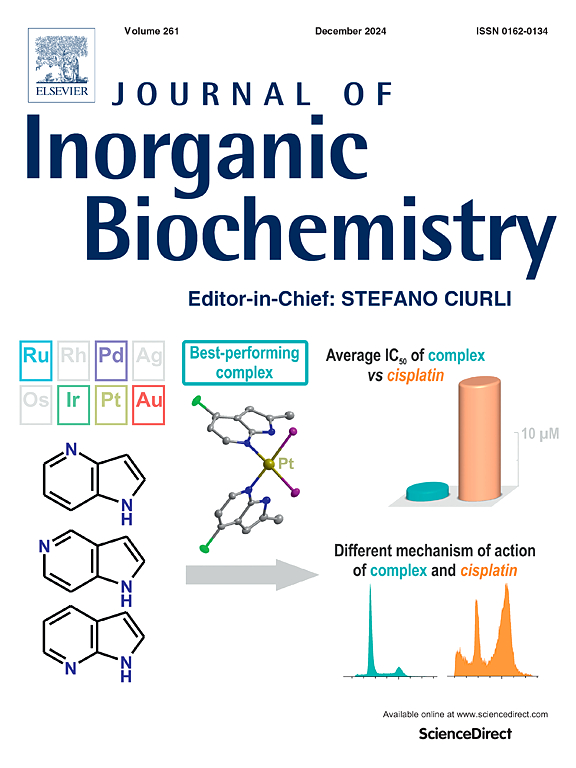Insight into uranyl binding by cyclic peptides from molecular dynamics and density functional theory
IF 3.8
2区 化学
Q2 BIOCHEMISTRY & MOLECULAR BIOLOGY
引用次数: 0
Abstract
It is a challenging task to develop uranyl-chelating agents based on peptide chemistry. A recently developed cationic dummy atom model of uranyl in conjunction with the classical molecular dynamics simulation presents a helpful utility to study the chelation of uranyl by peptides with a low computational cost. In the present study, it was used to describe the chelation of uranyl by the cyclic decapeptide with 4 Glu residues cyc-GluArgGluProGlyGluTrpGluProGly and its derivatives containing two phosphorylated serines in place of two Glu, termed pS16, pS18, pS38, and pS68. The obtained structures were further studied by density functional theory (DFT) and subsequent density analysis. We show that a combination of steered molecular dynamics and simulated annealing, using standard forcefields for peptide with the cationic dummy atom model of uranyl, can quickly and reliably obtain binding modes of uranyl-peptide complexes. Classical molecular dynamics simulation in explicit water produces geometry very close to the DFT-optimized structure. The presence of uranyl completely changes the conformation of these cyclic peptides from unstructured to organised. The simulation of a peptide with two uranyl units explained why only the 1:1 ratio of peptide and chelated-uranyl is observed experimentally in most cases, by the insufficiency of the anionic residues for the chelation of two UO22+ units, but that pS16 can accommodate two such units.

从分子动力学和密度泛函理论看环肽与铀酰的结合。
基于肽化学的铀酰螯合剂的开发是一项具有挑战性的任务。最近建立的铀酰阳离子虚拟原子模型结合经典的分子动力学模拟,为研究肽与铀酰的螯合提供了一种较低计算成本的实用工具。在本研究中,它被用来描述含有4个Glu残基的环十肽cyc-GluArgGluProGlyGluTrpGluProGly及其衍生物含有两个磷酸化丝氨酸代替两个Glu,称为pS16, pS18, pS38和pS68。通过密度泛函理论(DFT)和密度分析对得到的结构进行了进一步研究。研究表明,将分子动力学和模拟退火相结合,利用标准多肽力场和铀酰的阳离子虚拟原子模型,可以快速可靠地获得铀酰-肽配合物的结合模式。在显式水中的经典分子动力学模拟产生了非常接近dft优化结构的几何形状。铀酰的存在完全改变了这些环状肽的构象,使其从无结构变为有组织。对具有两个铀酰单元的肽的模拟解释了为什么在大多数情况下实验中只能观察到肽和螯合铀酰的1:1比例,因为两个UO22+单元螯合的阴离子残基不足,而pS16可以容纳两个这样的单元。
本文章由计算机程序翻译,如有差异,请以英文原文为准。
求助全文
约1分钟内获得全文
求助全文
来源期刊

Journal of Inorganic Biochemistry
生物-生化与分子生物学
CiteScore
7.00
自引率
10.30%
发文量
336
审稿时长
41 days
期刊介绍:
The Journal of Inorganic Biochemistry is an established international forum for research in all aspects of Biological Inorganic Chemistry. Original papers of a high scientific level are published in the form of Articles (full length papers), Short Communications, Focused Reviews and Bioinorganic Methods. Topics include: the chemistry, structure and function of metalloenzymes; the interaction of inorganic ions and molecules with proteins and nucleic acids; the synthesis and properties of coordination complexes of biological interest including both structural and functional model systems; the function of metal- containing systems in the regulation of gene expression; the role of metals in medicine; the application of spectroscopic methods to determine the structure of metallobiomolecules; the preparation and characterization of metal-based biomaterials; and related systems. The emphasis of the Journal is on the structure and mechanism of action of metallobiomolecules.
 求助内容:
求助内容: 应助结果提醒方式:
应助结果提醒方式:


